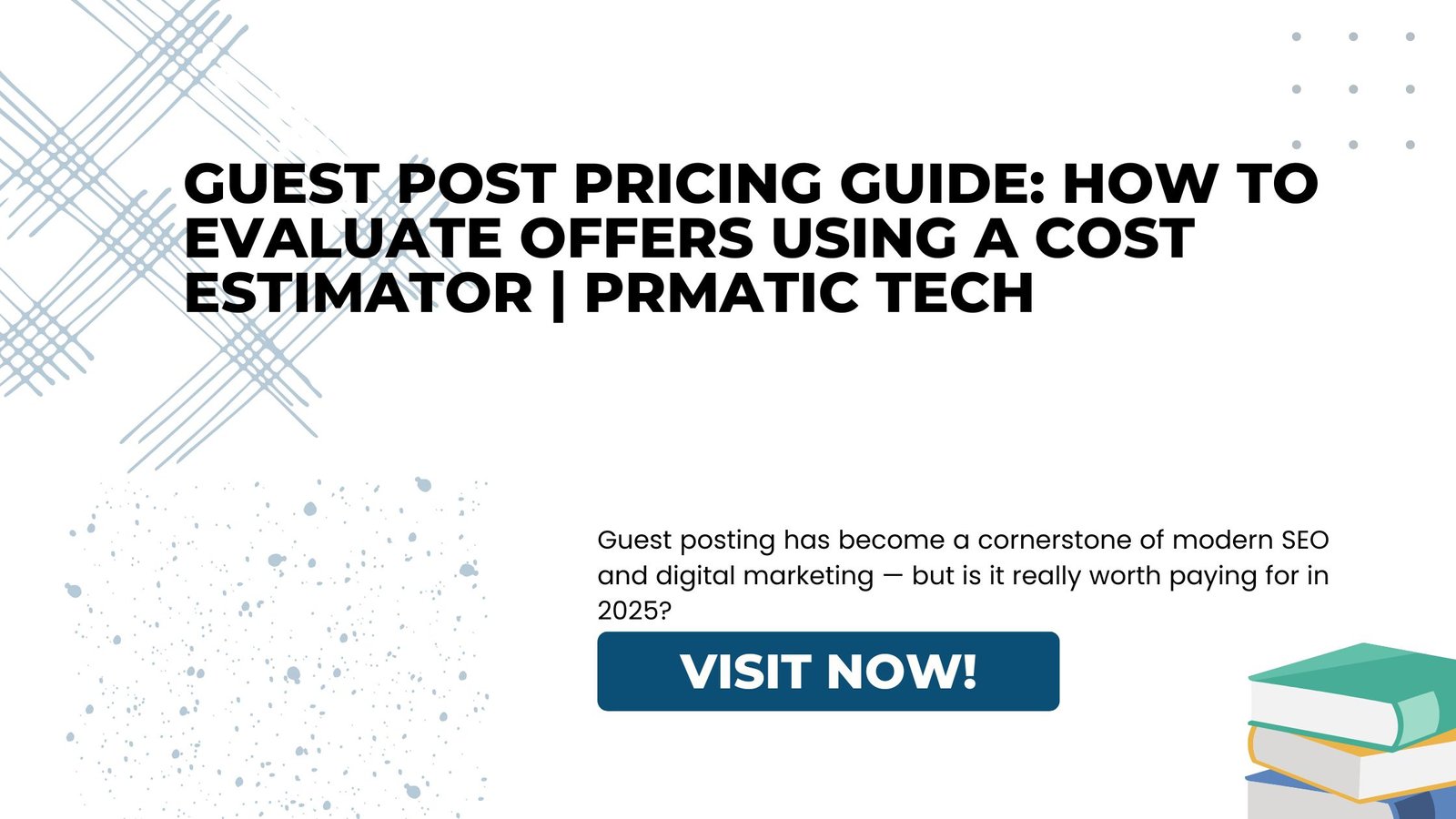Guest posting has become one of the most effective ways to boost your website’s authority, increase organic traffic, and improve search engine rankings. However, with prices ranging from just a few dollars to several thousand per placement, figuring out what a guest post is really worth can be confusing.
In this detailed guide, we’ll explain how to evaluate guest post offers, what factors influence pricing, and how to use the Promatic Tech Full Guest Post Cost Estimator to calculate fair market rates before you invest.
Why Guest Post Pricing Varies So Much
Guest posting is not a one-size-fits-all service. The cost depends on numerous factors — from the authority of the website to the quality of content being published. Understanding these pricing variables helps you make informed decisions and avoid overpaying for low-quality placements.
1. Domain Authority (DA) or Domain Rating (DR)
Websites with a higher DA/DR are typically more trusted by Google, so links from them carry more SEO weight.
- Low DA (10–30): $30–$100
- Medium DA (40–60): $150–$600
- High DA (70+): $800–$3,000+
2. Organic Traffic and Audience Engagement
Sites with real, verifiable traffic can justify higher rates. If a guest post can send you referral visitors, not just link equity, it’s more valuable.
3. Niche Relevance
A link from a niche-relevant website (e.g., a tech guest post on a tech site) is far more beneficial than one from a general blog. Search engines reward topical relevance.
4. Content Quality and Word Count
Posts that are longer, more researched, and well-written cost more to produce and publish. For example, a 1,500-word SEO-optimized article will cost more than a 600-word basic submission.
5. Link Placement
A contextual, dofollow link within the main content body is more valuable than one in an author bio or footer. Always confirm where your backlink will appear.
6. Website Reputation and Editorial Standards
Some high-profile websites charge more because they have strong editorial review processes, higher trust scores, and stricter publishing guidelines.
How to Evaluate a Guest Post Offer
Before you pay for a guest post, it’s essential to evaluate whether the deal provides real SEO and branding value. Here’s how to analyze offers professionally.
Step 1: Check Domain Metrics
Use SEO tools like Ahrefs, SEMrush, or Moz to assess:
- Domain Rating (DR) or Authority Score
- Monthly Organic Traffic (Ahrefs or SimilarWeb)
- Spam Score (Moz)
Avoid any website with unusually high outbound links or spammy link patterns — it could hurt your SEO.
Step 2: Review the Website’s Content Quality
Look at existing posts. Are they relevant, well-written, and active? If a site posts random or unrelated guest content daily, it’s likely a link farm.
Step 3: Confirm Link Placement
Ask the publisher where your link will be placed — in the article body, author bio, or sidebar. Only contextual body links carry significant SEO power.
Step 4: Estimate Real Traffic Impact
Even if a site has a high DR, it’s useless if it has zero real visitors. Check if articles actually rank and get organic traffic.
Step 5: Use a Guest Post Cost Estimator
Once you’ve gathered data, use a reliable tool like the Promatic Tech Full Guest Post Cost Estimator to calculate a fair cost range. It considers site authority, traffic, and content requirements to give you a realistic price expectation.
How to Use Promatic Tech’s Guest Post Cost Estimator
Promatic Tech’s estimator helps marketers and agencies calculate guest post pricing accurately — saving time and preventing overspending. Here’s how to use it:
- Visit the tool:
👉 Promatic Tech Full Guest Post Cost Estimator - Enter your target metrics:
- Domain Authority (DA/DR)
- Monthly traffic range
- Content length (e.g., 800–1,500 words)
- Number of placements
- Get estimated costs:
The tool instantly shows you a projected pricing range for your desired specifications. - Compare offers:
Use these results as a benchmark when evaluating quotes from guest post vendors, agencies, or website owners. - Make data-driven decisions:
Choose placements that fit your budget and offer the highest SEO and traffic ROI.
Example Cost Scenarios
Scenario 1: Mid-Tier Tech Blog
- Metrics: DR 45, 10K monthly visitors, 1,200-word post
- Estimated Cost (using estimator): $400–$700
- Expected ROI: 10–20% boost in organic traffic within 2–3 months
Scenario 2: Premium Authority Site
- Metrics: DR 80, 100K+ monthly visitors
- Estimated Cost: $1,500–$3,000
- Expected ROI: Long-term backlink authority and brand visibility
Scenario 3: Low-Tier General Blog
- Metrics: DR 25, 1K monthly visitors
- Estimated Cost: $50–$150
- Expected ROI: Minimal SEO impact, low referral traffic
Takeaway: Paying a bit more for high-quality, relevant sites generally produces better long-term results than buying dozens of cheap links.
Tips for Getting the Best Guest Post Deals
- Negotiate with Data:
When you know the fair market value using Promatic Tech’s estimator, you can negotiate confidently and avoid overpaying. - Bundle Placements:
Many publishers offer discounts for multiple posts. Consider purchasing in bulk for better ROI. - Avoid link Farms:
Check if the website posts too frequently or accepts unrelated guest posts — that’s a red flag. - Measure Post Performance:
Track referral traffic, rankings, and conversions from each guest post using UTM parameters. - Focus on Relevance, Not Just DR:
A niche-relevant DR 40 site often beats a random DR 80 site in long-term SEO impact.
Calculating ROI from Guest Posting
To assess whether your investment is worthwhile, calculate ROI based on both direct and indirect gains.
ROI Formula:
ROI = (Total Benefits – Cost) / Cost × 100
Example:
- Guest Post Cost: $600
- New Leads: 10 × $60 = $600
- SEO Value (traffic gain): $300
ROI = (900 – 600) / 600 × 100 = 50%
Even a modest ROI is valuable if it improves domain authority and long-term rankings.
Final Thoughts
Guest posting is one of the best ways to strengthen your SEO profile, but only if you pay fair prices and target the right websites. Always evaluate offers using real metrics, verify site authenticity, and estimate costs using trusted tools like the Promatic Tech Full Guest Post Cost Estimator.
This data-driven approach ensures you spend wisely, avoid scams, and achieve maximum ROI from your link-building campaigns.
If you’re planning a guest posting strategy this year, start by analyzing your costs and expected returns — and let Promatic Tech’s estimator be your guide.
✅ In Summary
- Guest post costs vary widely based on site authority, relevance, and quality.
- Evaluate every offer using data — not just promises.
- Use the Promatic Tech Cost Estimator to find fair pricing before buying placements.
- Focus on niche relevance, traffic quality, and editorial integrity for the best ROI.




